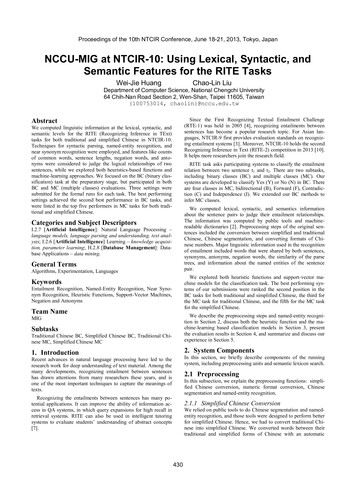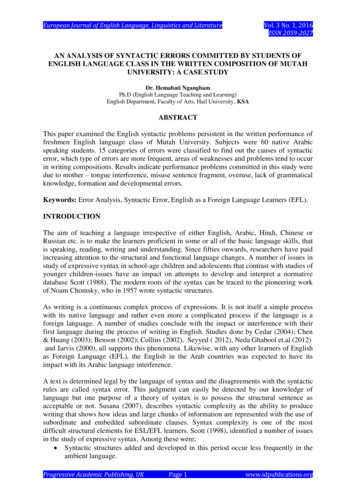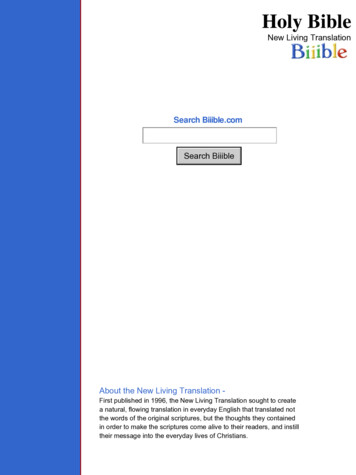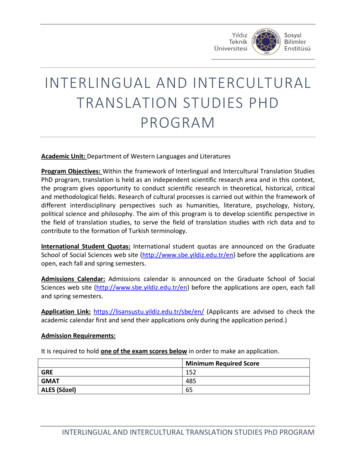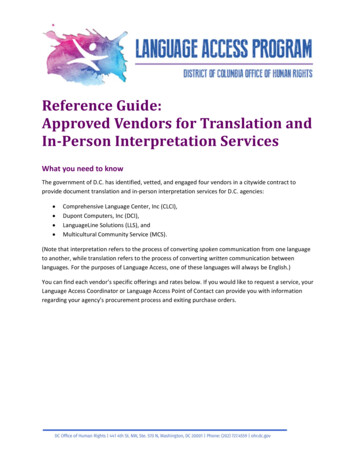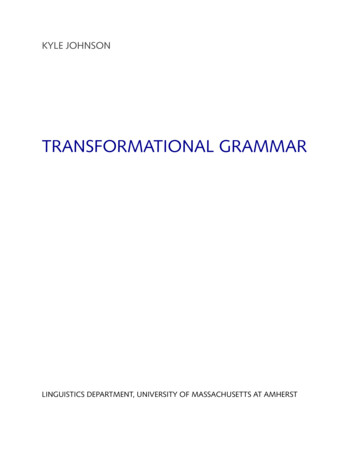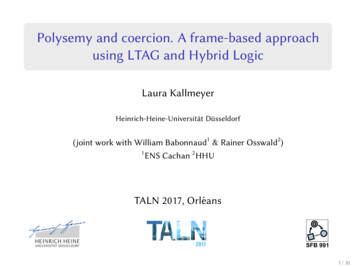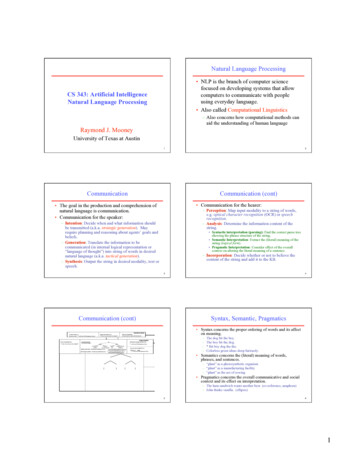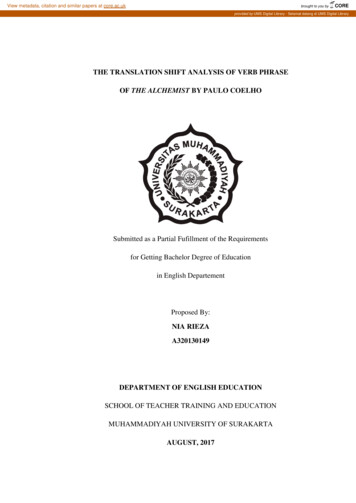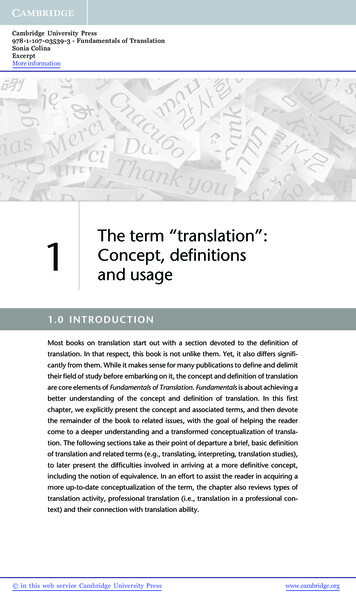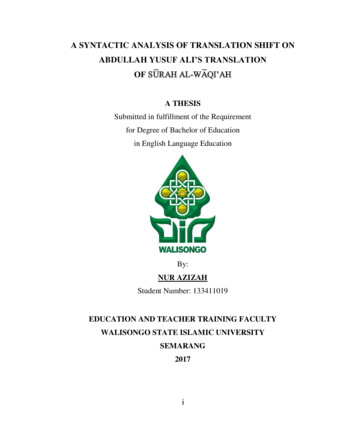
Transcription
A SYNTACTIC ANALYSIS OF TRANSLATION SHIFT ONABDULLAH YUSUF ALI’S TRANSLATIONOF SU RAH AL-WA QI’AHA THESISSubmitted in fulfillment of the Requirementfor Degree of Bachelor of Educationin English Language EducationBy:NUR AZIZAHStudent Number: 133411019EDUCATION AND TEACHER TRAINING FACULTYWALISONGO STATE ISLAMIC UNIVERSITYSEMARANG2017i
KEMENTERIAN AGAMAUNIVERSITAS ISLAM NEGERI WALISONGOFAKULTAS ILMU TARBIYAH DAN KEGURUANJl. Prof. Dr. Hamka (Kampus II) Ngaliyan Semarang, Telp (024) 7601295RATIFICATIONThesis with the following identity:Title: A Syntactic Analysis of Translation Shift on AbdullahYusuf Ali’s Translation of Su rah Al-Wa qi’ahName: Nur AzizahStudent Number: 133411019Department: English Language Educationhad been ratified by the board of examiner of Education and TeacherTraining Faculty Walisongo State Islamic University and can be received asone the requirements for gaining the Bachelor Degree in English LanguageEducation.Semarang, 16th of June 2017THE BOARD OF EXAMINERSChair Person,Secretary,Dr. Ikhrom, M. AgNIP. 19650329 199403 1 002Dra. Hj. Siti Mariam, M.PdNIP. 19650727 199203 2 002Examiner I,Examiner II,Dr. Muslih, MANIP. 19690813 199603 1 003Moh. Nafi Annury, M.PdNIP. 19780719 200501 1 007AdvisorsAdvisor I,Advisor II,Dr. H. Ahmad Ismail, MA, M. Hum.NIP: 19670208 199703 1 001Sayyidatul Fadlilah, M.PdNIP: 19810908 200710 2 001iii
ADVISOR APPROVALSemarang, 9th of June 2017Dear Sir,Dean of Education and Teacher Training FacultyWalisongo State Islamic UniversityAssalamu’alaikum, Wr. Wb.After correcting it to whatever extent necessary, we state that the finalproject belongs to student as bellow:Name of StudentStudent NumberDepartmentTitle: Nur Azizah: 133411019: English Language Education: A SYNTACTIC ANALYSIS OFTRANSLATION SHIFT ON ABDULLAHYUSUF ALI’S TRANSLATION OFSU RAH AL-WA QI’AHis ready to be submitted to Education and Teacher Training FacultyWalisongo State Islamic University to be examined at MunaqosyahSession.Wassalamu’alaikum, Wr. Wb.Advisor I,Dr. H. Ahmad Ismail, MA, M. Hum.NIP: 19670208 199703 1 001iv
ADVISOR APPROVALSemarang, 9th of June 2017Dear Sir,Dean of Education and Teacher Training FacultyWalisongo State Islamic UniversityAssalamu’alaikum, Wr. Wb.After correcting it to whatever extent necessary, we state that the finalproject belongs to student as bellow:Name of StudentStudent NumberDepartmentTitle: Nur Azizah: 133411019: English Language Education: A SYNTACTIC ANALYSIS OFTRANSLATION SHIFT ON ABDULLAHYUSUF ALI’S TRANSLATION OFSU RAH AL-WA QI’AHis ready to be submitted to Education and Teacher Training FacultyWalisongo State Islamic University to be examined at MunaqosyahSession.Wassalamu’alaikum, Wr. Wb.Advisor II,Sayyidatul Fadlilah, M. Pd.NIP: 19810908 200710 2 001v
ABSTRACTTitleWriterStudent Number: A Syntactic Analysis of Translation Shift onAbdullah Yusuf Ali’s Translation of Su rahAl-Wa qi’ah: Nur Azizah: 133411019Keyword: Translation Shift, Syntactic Analysis, AbdullahYusuf Ali’s TranslationThis study aimed to find out the kinds of translation shifts which wereintroduced by Catford (1965) found in the English translation of su rahal-Wa qi’ah in The Holy Qur’an, Text, Translation and Commentary(1934) by Abdullah Yusuf Ali. This study was library research whichused qualitative study. The data were collected throughdocumentation, including the theory of translation shift by J.C.Catford. The study used data analysis which adopted the stages fromJohn W. Creswell (2007) (preparing and organizing, coding andreducing, and interpreting and representing). The method of analysiswhich was used in this study was descriptive percentage analysis. Thisstudy focused on the syntactic analysis of translation shift on AbdullahYusuf Ali’s translation of su rah al-Wa qi’ah which has 96 verses. Theresult of this study showed that equivalence held the highest numberwith total numbers 40. Then, the most frequently found shift typesoccured in Abdullah Yusuf Ali’s translation of su rah al-Wa qi’ah(Arabic into English) were Unit Shift and Structure Shift with thepercentage of both is 44% (31) and 24% (17) from the total number ofshift is 70. The other three shift types did not show any significantlevel of number of shift. Class Shift held 16% (11). Then Level Shiftheld 13% (9). And the lowest number of shift was Intra-System Shiftwhich only held 2% (2). This result suggested that the moreequivalence occurred, the more valid a translated text. The use of shifthad always been considered an inseparable element of a good andreadable piece of translation. It more focused on syntactic pattern, so itwas good to be implemented in grammar lesson. Beside, the studentscould know the grammar lesson, they also know the structure of theHoly Qur’an verse.vi
TRANSLITERASI ARAB-LATINPenulisan transliterasi huruf-huruf Arab Latin dalam penelitian iniberpedoman pada SKB Menteri Agama dan Menteri Pendidikan danKebudayaan RI Nomor: 158/1987 dan Nomor: 0543b/U/1987. Penyimpanganpenulisan kata sandang [al-] disengaja secara konsisten supaya sesuai }yd}Bacaan Madd:a a panjangi i panjangu u panjangBacaan Diftong:au ْ اَو ai ْ اَي iy ْ اِي vii
DEDICATIONThis thesis is dedicated to: My beloved father and mother (Bapak Saiful Munir and IbuSukarti, who always devote their affection, give the best pray andeffort for me till I finished arranging this thesis. Thanks forgiving the writer never ending pray and unconditional love. Honorable, Dr. K.H. Fadlolan Musyaffa‟, Lc. MA., Ibu NyaiFenty Hidayah, S. Pd.I and the big family of Ma‟had al-Jami‟ahWalisongo Semarang, who have become my second parents andfamily in the place I study, from the year I study till the year Igraduated. Thanks for the guidance and the support. My beloved sister and brother, Ambarwati and Ahmad Zidan„Athoillah, who always wait for me to go home and become myspirit. My new and long-lasting friends, “Sekawan Doso”, KKN 67Posko 40 Desa Krobokan (Pak Krodes, Acil, Sipit, Bang Mu,Bang Lu, Pitchae, Cliqel, Tuan Putri, Eyang, Kak Linda, MommyHana, Mbok Jum), thanks for showing me that life is for devotionand being part of my life.viii
MOTTO . . But it is possible that ye dislike a thing which is good for you, andthat ye love a thing which is bad for you. But Allah knoweth, and yeknow not.1(QS. Al-Baqarah: 216)“Tidak ada sesuatu yang sulit dicapai, selama kamu mengusahakannyabersama Tuhanmu. Sebaliknya tidak ada yang mudah, jika kamumengusahakannya sendirian.” 2(Ibn „Atthaillah)Lebih baik menyalakan lampu daripada memaki kegelapan. (Azz)1Abdullah Yusuf Ali, 1934, The Holy Qur’an: Text, Translation,and Commentary, (Lahore: Goodword Books), pg. 152Ibnu Athaillah al-Sakandari, 2010, Al-Hikam: Untaian HikmahIbnu Atthaillah, (Jakarta: Zaman), pg. 37xi
TABLE OF CONTENTCOVER . iTHESIS PROJECT STATEMENT . iiRATIFICATION . iiiADVISOR APPROVAL . ivABSTRACT . viTRANSLITERATION . viiDEDICATION . viiiACKNOWLEDGEMENT . ixMOTTO . xiTABLE OF CONTENT . xiiLIST OF TABLE. xivABBREVIATIONS . xvCHAPTER I INTRODUCTION . 1A. Background of the Study . 1B. Question of the Study . 12C. Objective of the Study . 12D. Significances of the Study . 12E. Previous Study. 14F. Method of the Study . 17G. Thesis Organization. 23CHAPTER II TRANSLATION AND TRANSLATION SHIFTBY J.C. CATFORD . 24A. General Concept of Translation . 241. The Definition of Translation . 242. Translation Shift . 31B. Translation Shift in the Holy Qur’an . 48CHAPTER III ABDULLAH YUSUF ALI AND HISWORKS . 52A. Biography of Abdullah Yusuf Ali . 521. The Life of Abdullah Yusuf Ali. 52a. From Child-Hood to Adult-Hood . 52xii
b. The Career of Abdullah Yusuf Ali .53c. The Intellectual Thoughts ofAbdullah Yusuf Ali .55d. The Arts of Abdullah Yusuf Ali .56e. The End of Life of Abdullah YusufAli .58B. The Holy Qur’an: Text, Translation,and Commentary .581. The Background of the Holy Qur’an .58a. The Systematic Writing ofthe Holy Qur’an.59b. The Approach Used by AbdullahYusuf Ali in TranslatingThe Holy Qur’an.63C. General Overview of Su rah Al-Wa qi’ah .64CHAPTER IV TRANSLATION SHIFT IN ABDULLAH YUSUFALI’S TRANSLATION OF SU RAH ALW A QI’AH.66A. Translation shift in Abdullah YusufAli’s translation of su rah al-Wa qi’ah .67B. Discussion.98CHAPTER V CONCLUSION AND SUGGESTIONS .105A. Conclusion .105B. Suggestions .106REFERENCESAPPENDICESxiii
LIST OF TABLEPageTable 1.1 The analysis sample of translation shift . 22Table 2.1 The dimensions (forms of order) in language and their .ordering principles . 34Table 2.2 The example of plurality concept . 45xiv
ABBREVIATIONSSLSource LanguageTLTarget LanguageTit.Title of su rah al-Wa qi’ahLSLevel ShiftSSStructure ShiftCSClass ShiftUSUnit Shiftur.Upward Rank Shiftdr.Downward Rank ShiftISIntra-System ShiftEq.Equivalentxv
CHAPTER IINTRODUCTIONA. Background of the StudyThe study of text based-translation had been widely examinedby some researchers around the world. Whether they examined thevalidity of the translation or tried to build a translation theory toeasily translate a written text from Source Language (SL) to TargetLanguage (TL). The validity of translation should be examinedbecause not all of the terms can be translated to other languages. Thisis because every language has its own term to call a specific thing. Asthe same as the Holy Qur‟an, it cannot be translated accurately toother languages. As stated by Pickthall that he maintained that theHoly Qur‟an being Word of God could not be translated.1Translation is not only translating each words or phrases fromSL into TL, but also looking for the equivalent of meaning ormessage in SL. It can be stated that every language has its ownstructure and culture. This difference causes the variation on how thetranslator translates the text. The SLmust not always have theequivalent with the TL. So that, the TL can be „loss‟ or „redundant‟ ifcompared to SL.2 Therefore, it is important to point out that there aresimilarities as well as differences between English and Arabic1M. Marmaduke Pickthall, 2005, The Qur’an Translated (Messagefor Humanity), (Washington DC: ICSFP), pg. 6382M. Zaka Al Farisi, 2011, Pedoman Penerjemahan Arab-Indonesia,(Bandung: PT Remaja Rosdakarya), pg. 281
structures. When there are similarities exist, translation process willbe easy. However, there will always be different grammatical patternbetween SL and TL. The translators must consider some grammaticaland lexical equivalents. In the translation activity, a translator tries tofind out the equivalent of SL text to TL text. The equivalent is thecorrespond content of the messages of SL to TL text.To understand more about Arabic structure, the scholarschoose the Holy Qur‟an as the medium of observation. The Arabicstructure which is used in the Holy Qur‟an is really unique. It makesthe verse in the Holy Qur‟an is understandable and has theappropriate rule. The system of phonology, syntax, morphology, etc.which are related to language system in Arabic is different with otherlanguage systems. Moreover, it cannot be found in other languages.Arabic has been chosen as a medium of the revealed language forevery language speakers in the world. It has been chosen to prove thesecret of the Qur‟anic language. The Holy Qur‟an is the kalam Allahwhich was revealed to Prophet Muhammad PBUH through Jibril. It isas a source of moral teaching and the guidance for human (hudan lial-nas).3 Islam (read: the Holy Qur‟an) was sent down for humanwholly. However, it had to face a certain human community.Therefore, the Holy Qur‟an was sent down as the main guidance ofIslam in a certain language. Allah had chosen Arab and Arabiclanguage as the media of the Holy Qur‟an content. The language usedin the Holy Qur‟an is a well-known language and considered as the32Al-Baqarah [2]: 185
best language by the societies in the location where Islam firstappeared. It is because of there is no language which explained itsteachings except using a language where it appeared. This case islogic and also stated in the Holy Qur‟an: ( We sent not a messenger except [to teach] in the language ofhis [own] people, in order to make [things] clear to them. NowAllah leaves straying those whom He pleases and guideswhom He pleases: and He is Exalted in power, full ofWisdom. (QS. Ibrahim: 4)4The Holy Qur‟an which is originally in Arabic language hasbeen translated to other language, especially English, to provideMuslims who did not understand the Holy Qur‟an in Arabiclanguage. For many centuries, many translators have translated theHoly Qur‟an into English. They are George Sale (1734), M.Marmaduke Pickhall (1930), Abdullah Yusuf Ali (1934), MaulviSher Ali (1936), Arthur John Arberry (1955), Muhammad MuhsinKhan (1985), Tahereh Saffarzadeh (2001) and others.5 From those4Abdullah Yusuf Ali, 1934, The Holy Qur’an: Text, Translation,and Commentary, (Lahore: Goodword Books)5https://en.wikipedia.org/wiki/List of translations of the Qur‟an3
translators, they had different background that caused the differencein understanding and translating the meaning of the Holy Qur‟an.As the students of Islamic based-campus, Walisongo StateIslamic University, they often quoted a verse within its Englishtranslation to relate the subject to the Holy Qur‟an. Moreover, therehas been an Islamic boarding house which is owned by WalisongoState Islamic University Semarang, named Ma‟had al-Jami‟ahWalisongo. One of activities that related to this study is speechprogram in the early morning. In making a speech text, the studentsoften include a verse of the Holy Qur‟an within its English translationto relate the material to the Holy Qur‟an. They quote the translationof the verse of the Holy Qur‟an without knowing who the translatoris. As I examine, every translator is different. Each translator has hisown background that influences the translation, for example, theEnglish translation of QS. al-Fath verse 29. .Pickthall: “Muhammad is the messenger of Allah. And those with himare hard against the disbelievers and merciful among themselves”.Arberry: “Muhammad is the Messenger of God, and those who arewith him are hard against the unbelievers, merciful one to another”.4
Saffarzadeh: “Mohammad is the Messenger of Allah And hisfollowers are stern and hard Against the disbelievers but kind andCompassionate to each other”.Iranpanah: “Muhammad is the Messenger of Allah, and those who arewith him are hard against the unbelievers, merciful one to another”.In most of the translations of the first part of the verse,the translators mostly have takenmobtada andas subject or, as the predicate or khabar. Thus, they havetranslated this part of the verse as “Muhammad is the messenger ofAllah” or “Muhammad is the messenger of God”. The problem is thatafter the Great Victory, as promised by God to the Prophet, there wasno doubt that the prophet was the Messenger of God. So, the questionis that what can be the intended message of this verse after years ofthe messenger‟s Prophethood is confirmed under the name ofMuhammad? As a result,, is not the predicate or khabar inthe above verse. In fact, the syntactic function of, is na’t oratof bayan in this case. In other words, the predicate or khabar of theverse is. Tabarsi has mistranslated this verse, whereas thesyntactic analysis provided by him confirms the translation of thisverse as the present project puts it. He says:5
Based on these facts, an acceptable translation of the first partof present verse is one in whichis syntactically used as anon-defining phrase or appositive referring toas it can be foundin the following translation by Qara‟i.“Muhammad, the apostle of Allah, and those who are withhim are hard against the faithless and merciful amongstthemselves.”None of the four translations is acceptable due to such amisunderstanding of syntactic pattern of the given appositive in theverse.6The above explanation could be examined in terms oftranslation shift by Catford (1965), where the translation wasexamined by analyzing the correspondence of the SL structure.Catford divided the shift as follow.1. Level shift. It means an SL item at one linguistic level has a TLtranslation equivalent at a different level.6Alizadeh & Jahanjouyan. An Evaluation of the English Translationof Some Grammatical Pattern in the Noble Qur’an (Unpublished), pg. 6866876
2. Category shift. It means there is a change or shift in translationfrom formal correspondence and from the same level betweenboth languages.a. Structure shift. It means the change of grammatical structureor word sequence in a sentence.b. Class shift. It means the translation equivalent of an SL itemis a member of a different class from the original item.c. Unit shift. It means changes of rank-that is, departures fromformal correspondence in which the translation equivalent ofa unit at one rank in the SL is a unit at a different rank in theTL.d. Intra-system shift. It means those cases where the shift occursinternally, within a system; that is, for those cases where SLand TL possess systems which approximately correspondformally as to their constitution, but when translationinvolves selection of a non-corresponding term in the TLsystem. 7We know that the Holy Qur‟an is written in Arabic language.Some of the translators are good in Arabic and Muslim, so that theycan translate the Holy Qur‟an to English accurately. But some of themare not really good in Arabic and not Muslim (e.g. Orientalist). Forexample, George Sale is an Orientalist that Christianized his7J. C. Catford, 1965, A Linguistic Theory of Translation. (London:Oxford University Press), pg. 3-807
translation of the Holy Qur‟an.8 Christianizing means the use of wordsor terms that have correlation with the Christianity. For example, insurah Ya Seen in verse 13, 16, and 52 he translated “apostle” as anequivalent for (mursalu n)and (rasu l)in verse 30.According to Betz (2005), “the word apostle is known mainly fromthe Christian religion as a title of a religious leader, especially in earlyChristianity”. In Cambridge Advanced Learner‟s Dictionary, “apostle”means the group of early Christians who travelled to different placestelling people about Jesus Christ and the gospel.9 George Sale didknow the difference between “messenger” and “apostle” because heuses the former twice in verse 3 and 20, and the latter six times inverse 13, 14, 16, 19, 30 and 52, to advance his own version ofChristianity. This case should be examined in order to give awarenessto people, especially students in Islamic University, that they shouldbe careful to quote English translation of the Holy Qur‟an. In addition,they also should be aware of that in taking a quotation, they shouldpay attention to the reference that the translator should have sanad(relation) to Prophet Muhammad PBUH as stated in the followingverse of the Holy Qur‟an and Hadith:8Ebrahim Khodadady, 2013, A Comparative Analysis of TwoEnglish Translations of Ya Seen (Q.36): A Schema-Based Approach, Vol. 4No. 13, (Mashhad: IJBSS), pg. 1689Cambridge Advanced Learner’s Dictionary (Third Edition, 2010),Singapore: Cambridge University Press, pg. 238
( Before thee, also, the messengers We sent were but men, towhom We granted inspiration: If ye realise this not, ask ofthose who possess the Message. (QS. Al-Anbiya‟:7)10'Abdullah b. 'Amr b. al-'As reported Allah's Messenger (maypeace be upon him) as saying: Verily, Allah does not takeaway knowledge by snatching it from the people but He takesaway knowledge by taking away the scholars, so that when Heleaves no learned person, people turn to ignorant as their,leaders; then they are asked to deliver religious verdicts andthey deliver them without knowledge, they go astray, and leadothers astray.(Muslim: Book 034, Number 6462)11In QS. Al-Anbiya‟: 7, it told us about the history of ProphetMuhammad PBUH‟s mission as rasu l. It is explained thatunbelievers deny it because they thought that rasu l must be from10Abdullah Yusuf Ali, 1934, The Holy Qur’an: Text, Translation,and Commentary, (Lahore: Goodword Books)11Abd-al-Hamid Siddiqui, 2009, Sahih Muslim (1st Edition), pg.15999
angels (malaikah). Whereas, this verse explains clearly that rasu l isfrom human and the angels are not called raju l as mentioned by thisverse.12 Then, this verse also explains that if they (read: unbelievers)did not know about this case, then they should ask to ahl al-z#ikr. Ahlal-z#ikr means the expert of Taurat and Bible (Jews and Christian)who believed to Prophet Muhammad PBUH.13 They were the peoplewho lived in the past. Because of Prophet Muhammad SAW PBUH ishuman, he needs to eat, drink, and sleep. As a human, he is noteternal. He taught his knowledge to his companions in order tocontinue it to the next generations. So, in this time, we cannot askdirectly to him if there is a problem. We only can ask to ahl al-z#ikr orit can be called ulama ’. Because ulama ’ has sanad or relation toProphet Muhammad PBUH.To make the Holy Qur‟an as a way of life, it needs an effort tounderstand its messages. This kind of activity is called tafsi r orinterpretation.14 Tafsi r is a way to explain the meaning of Allah‟sword according to the capability of an interpreter. Tafsi r is also aresult of dialectic between static text and dynamic context which arealways changing.12Syaikh Imam Al Qurthubi, 2008, Tafsir Al Qurthubi [11],(Jakarta: Pustaka Azzam), pg. 726-72713M. Quraish Shihab, 2002, Tafsir Al-Mishbah: Pesan, Kesan, danKeserasian the Holy Qur’an, (Jakarta: Lentera Hati), pg. 1514M. Quraish Shihab, 2006, “Membumikan” the Holy Qur’an:Fungsi dan Peran Wahyu dalam Kehidupan Bermasyarakat, (Bandung:Mizan), pg. 1510
One of the translations and interpretations of the Holy Qur‟anis The Holy Qur’an: Text, Translation, and Commentary by AbdullahYusuf Ali. Because of the low-attention from interpreters to thistranslation and interpretation, I eager to conduct a research byanalyzing its English translation to get the validity of Englishtranslation of the Holy Qur‟an.Based on the explanation above, I was interested inconducting a research related to this case. In hence, I conducted thisresearch by analyzing the English translation of the Holy Qur‟an interms of Translation Shift. I specified on one surah of the HolyQur‟an, that was al-Wa qi’ah, in The Holy Qur’an, Text, Translationand Commentary (1934) by Abdullah Yusuf Ali. Surah al-Wa qi’ahwas chosen because there had been many predictions about the end ofthe day which were told by some fortune tellers, for example Mayantribes. Based on many calculations, they predicted that the end of theday will occur on 21th of December of 2012. This case made theworld panic. Moreover, this kind of prediction was presented in a filmentitled “2012”. “2012” was a science-fiction disaster film that wasproduced in 2009 and directed by Roland Emmerich. This film wasproduced by Emmerich Company, Centropolis Entertainment, anddistributed by Columbia Pictures. This film was inspired by theglobal of the end of the day that was predicted by the Mayan tribesthrough the calculation of Maya Calendar in 21st of December 2012.15This film told about the situation and the condition of the end of the15https://id.wikipedia.org/wiki/2012 (film)11
day. However, it is not based on the Holy Qur‟an. Whereas, peopleshould get the valid understanding about how the end of the day willoccur. So that, surah al-Wa qi’ah which explains about the end of theday is the suitable surah to give valid understanding to them.B. Question of the StudyThe problem investigated in this study was “What kinds oftranslation shifts which are introduced by Catford (1965) found inthe English translation of surah al-Wa qi’ah in The Holy Qur’an,Text, Translation and Commentary (1934) by Abdullah YusufAli?”C. Objective of the StudyThe objective in this study was “To know kinds of translationshifts which are introduced by Catford (1965) found in Englishtranslation of surah al-Wa qi’ah in The Holy Qur’an, Text,Translation and Commentary (1934) by Abdullah Yusuf Ali.”D. Significances of the StudyThe result of this study was intended theoretically as a usefulresult for academic realm (students and lecturers), researcher, nextresearchers, the institution, and the readers. Based on the objectivesof the study, the benefits of the research could be stated as follow.12
1. For the students and the lecturersThis study could be a consideration of lecturers to decidethe validity of English translation of the Holy Qur‟an. Then, inIslamic-based campus, it was important to point out that inquoting an English translation of the Holy Qur‟an shouldconsider the validity of its translation and for good reason. Then,translation shift more focused on syntactic pattern, so it was goodto be implemented in grammar lesson. Beside, the students couldknow the grammar lesson, they also know the structure of theHoly Qur‟an verse.2. For the researcherFrom the result of this study, I hopefully could take andgive the benefits of this research to many people, such as, being abetter writer, knowing another official language (Arabic), andrelating the subjects to the Holy Qur‟an as a form of unity ofsciences.3. For the next researchersThis study could be a reference to do future researchrelated to English translation of the Holy Qur‟an field. They alsocould examine other translators.4. For InstitutionOngoing to be research Islamic university, WalisongoState Islamic University try to develop in research field whichquote the English translation of the Holy Qur‟an in every research13
or journal. This study could be a reference to measure the validityof meaning of English translation of the Holy Qur‟an.5. For the readersI hope that the study would give useful information for thereaders about translation shift in English translation of the HolyQur‟an.E. Previous StudyTranslation is an interesting field to be researched. Manyresearchers have conducted the research about translation, especiallyon the Holy Qur‟an translation. Related to this study, I chose someprevious researches which were relevant to the English translation ofthe Holy Qur‟an.1. “An Analysis of English-Indonesian Translation Shift in TheHannah Banana Short Story by Ribut Wahyudi” by SitiMuhtalifah. This study examined the change from Englishlanguage structure to Indonesian language structure. Theresearcher also classified the story text into some kinds ofshift translation. This structure change happened because ofthe different structure of both languages. For example,Indonesia language does not have the tense form. Thisprevious study used qualitative method.The result of the previous study showed that theresearcher found some translation shifts in the HannahBanana. They are: A change of word category occurs from a14
plural to a singular noun, from adjective–noun in Englishbecomes noun- noun in Indonesia, the noun–adjectivebecomes the noun-adjective (the same structure), and thereplacement of a virtual lexical gap in Bahasa Indonesia by agrammatical structure and from adjective-noun in English intonoun-adjective in Bahasa Indonesia.16The above previous research has inspired and motivatedme to conduct a research applying Translation Shift in Englishtranslation of the Holy Qur‟an. I conducted the research onEnglish translation of the Holy Qur‟an which was translatedby Abdullah Yusuf Ali entitled The Holy Qur’an, text,translation and commentary (1934). Therefore, the differencesbetween her research and my r
Keyword: Translation Shift, Syntactic Analysis, Abdullah Yusuf Ali's Translation This study aimed to find out the kinds of translation shifts which were introduced by Catford (1965) found in the English translation of su rah al-Wa qi'ah in The Holy Qur'an, Text, Translation and Commentary (1934) by Abdullah Yusuf Ali.
